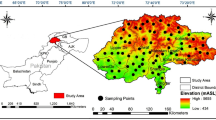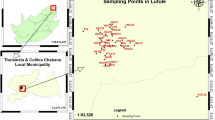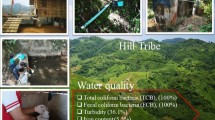Abstract
The focus of the present study was to assess the quality of different drinking water sources, impacts of poor water quality on human health, and to apportion pollution source(s) of the district Bajaur, Pakistan. Drinking water samples (n = 331) were randomly collected from springs, hand pumps, open wells, and tube wells and analyzed for physicochemical parameters including toxic elements, and bacteriological contamination (i.e., Escherichia coli). Furthermore, a questionnaire survey was conducted to record the cases of waterborne diseases in the study area. The results showed that total suspended solids and bacteriological contamination exceeded the permissible limits of the WHO in all four of the water sources. Among the potentially toxic elements, Cd, Pb, and Mn were above the permissible limits of the WHO in some samples. The hazard index for spring water was found to exceed the toxicity level (i.e., HI > 1) set by US EPA for both adults and children, while the sources from hand pumps, open wells, and tube wells were within the safe limit. The order for the overall safety level for water quality in the study area was tube wells > open wells > hand pumps > springs. The pollution source apportionment statistics revealed that both geogenic and anthropogenic activities are the sources of drinking water contamination. The results of the questionnaire survey indicated that reports of waterborne diseases were highest in respondents who took their drinking water from springs, whereas reports of diseases were moderate in respondents taking their water from open wells and hand pumps and lowest in respondents taking their water from tube wells. Based on the findings of the study, the tube well source of water is recommended for drinking water purposes.







Similar content being viewed by others
Explore related subjects
Discover the latest articles and news from researchers in related subjects, suggested using machine learning.References
Abdalla F, Khalil R (2018) Potential effects of groundwater and surface water contamination in an urban area, Qus City, Upper Egypt. J Afr Earth Sci 141:164–178. https://doi.org/10.1016/j.jafrearsci.2018.02.016
Adimalla N, Qian H (2019) Groundwater quality evaluation using water quality index (WQI) for drinking purposes and human health risk (HHR) assessment in an agricultural region of Nanganur, south India. Ecotoxicol Environ Saf 176:153–161. https://doi.org/10.1016/j.ecoenv.2019.03.066
Ahmed J, Wong LP, Chua YP et al (2020) Quantitative microbial risk assessment of drinking water quality to predict the risk of waterborne diseases in primary-school children. Int J Environ Res Public Health 17:1–16. https://doi.org/10.3390/ijerph17082774
Amin R, Zaidi MB, Bashir S et al (2019) Microbial contamination levels in the drinking water and associated health risks in Karachi, Pakistan. J Water Sanit Hyg Dev 9:319–328. https://doi.org/10.2166/washdev.2019.147
APHA (1989) Standar methods for the examination of water and wastewater
Arain MB, Ullah I, Niaz A et al (2014) Evaluation of water quality parameters in drinking water of district Bannu, Pakistan: multivariate study. Sustain Water Qual Ecol 3:114–123. https://doi.org/10.1016/j.swaqe.2014.12.005
Balamurugan P, Kumar PS, Shankar K et al (2020) Non-carcinogenic risk assessment of groundwater in southern part of Salem district in Tamilnadu, India. J Chil Chem Soc 65:4697–4707. https://doi.org/10.4067/S0717-97072020000104697
Begum S, Shah MT, Muhammad S, Khan S (2015) Role of mafic and ultramafic rocks in drinking water quality and its potential health risk assessment, Northern Pakistan. J Water Health 13:1130–1142. https://doi.org/10.2166/wh.2015.066
Bosan A, Qureshi H, Bile KM et al (2010) A review of hepatitis viral infections in Pakistan. J Pak Med Assoc 60:1045–1058
Cairncross S, Feachem R (2018) Environmental health engineering in the tropics. Routledge. https://www.taylorfrancis.com/books/environmental-health-engineering-tropics-sandy-cairncross-richard-feachem/10.4324/9781315883946
Daud MK, Nafees M, Ali S et al (2017) Drinking water quality status and contamination in Pakistan. Biomed Res Int. https://doi.org/10.1155/2017/7908183
Delpla I, Proulx F, Rodríguez MJ (2020) A methodology to prioritize spatio-temporal monitoring of drinking water quality considering population vulnerability. J Environ Manag. https://doi.org/10.1016/j.jenvman.2019.109869
Dieter HH, Bayer TA, Multhaup G (2005) Environmental copper and manganese in the pathophysiology of neurologic diseases (Alzheimer’s disease and manganism). Acta Hydrochim Hydrobiol 33:72–78. https://doi.org/10.1002/aheh.200400556
Ding J, Jiang Y, Fu L et al (2015) Impacts of land use on surface water quality in a subtropical river basin: a case study of the dongjiang river basin, Southeastern China. Water (Switzerland) 7:4427–4445. https://doi.org/10.3390/w7084427
Divahar R, Aravind Raj PS, Sangeetha SP, Mohanakavitha T (2019) Impact of industrial wastewater disposal on surface water bodies in kalingarayan canal, Erode district. Indian J Ecol 46:823–827
He S, Wu J (2019) Relationships of groundwater quality and associated health risks with land use/land cover patterns: a case study in a loess area, Northwest China. Hum Ecol Risk Assess 25:354–373. https://doi.org/10.1080/10807039.2019.1570463
Horiguchi H, Oguma E, Sasaki S et al (2013) Age-relevant renal effects of cadmium exposure through consumption of home-harvested rice in female Japanese farmers. Environ Int 56:1–9. https://doi.org/10.1016/J.ENVINT.2013.03.001
Hussain R, Khattak SA, Sattar S et al (2020) Evaluation of the contaminated soil and its impacts on Tobacco (Nicotiana tabacum L.) crops in Swabi, Pakistan. J Himal Earth Sci 53:34–48
Järup L (2003) Hazards of heavy metal contamination. Br Med Bull 68:167–182. https://doi.org/10.1093/bmb/ldg032
Jehan S, Khan S, Khattak SA et al (2019) Hydrochemical properties of drinking water and their sources apportionment of pollution in Bajaur agency, Pakistan. Measurement 139:249–257. https://doi.org/10.1016/j.measurement.2019.02.090
Ji Y, Wu J, Wang Y et al (2020) Seasonal variation of drinking water quality and human health risk assessment in Hancheng City of Guanzhong Plain, China. Expo Health 12:469–485. https://doi.org/10.1007/s12403-020-00357-6
Khan S, Shahnaz M, Jehan N et al (2013) Drinking water quality and human health risk in Charsadda district, Pakistan. J Clean Prod 60:93–101
Khan HM, Muhammad N, Nafees M et al (2018) Spatial distribution and pollution source (s) apportionment in adjacent tributaries of River Panjkora. J Biodivers Environ Sci 12:391–403
Li P, Tian R, Liu R (2019) Solute geochemistry and multivariate analysis of water quality in the Guohua phosphorite mine, Guizhou Province, China. Expo Heal 11:81–94. https://doi.org/10.1007/s12403-018-0277-y
Malik AH, Khan ZM, Mahmood Q et al (2009) Perspectives of low cost arsenic remediation of drinking water in Pakistan and other countries. J Hazard Mater 168:1–12
Muhammad N, Nafees M (2018) Geo-chemical investigation and health risk assessment of potential toxic elements in industrial wastewater irrigated soil: a geo-statistical approach. J Biodivers Environ Sci 12:367–380
Muhammad N, Nafees M, Hussain R et al (2018) Pollution and energy reduction strategy in soft drink industries. Environ Sci Pollut Res 25:28153–28159. https://doi.org/10.1007/s11356-018-2861-x
Nawaz S, Ali Y (2018) Factors affecting the performance of water treatment plants in Pakistan. Water Conserv Sci Eng 3:191–203. https://doi.org/10.1007/s41101-018-0051-9
Muhammad N, Nafees M, Khan MH et al (2020) Effect of biochars on bioaccumulation and human health risks of potentially toxic elements in wheat (Triticum aestivum L.) cultivated on industrially contaminated soil. Environ Pollut 260:1–12. https://doi.org/10.1016/j.envpol.2019.113887
Nawab J, Khan S, Khan MA et al (2017) Potentially toxic metals and biological contamination in drinking water sources in chromite mining-impacted areas of pakistan: a comparative study. Expo Health 9:275–287
Nawab J, Farooqi S, Xiaoping W et al (2018) Levels, dietary intake, and health risk of potentially toxic metals in vegetables, fruits, and cereal crops in Pakistan. Environ Sci Pollut Res 25:5558–5571. https://doi.org/10.1007/s11356-017-0764-x
Owens CEL, Angles ML, Cox PT et al (2020) Implementation of quantitative microbial risk assessment (QMRA) for public drinking water supplies: systematic review. Water Res 174:115614
Panneerselvam B, Paramasivam SK, Karuppannan S et al (2020) A GIS-based evaluation of hydrochemical characterisation of groundwater in hard rock region, South Tamil Nadu India. Arab J Geosci. https://doi.org/10.1007/s12517-020-05813-w
Peavy HS, Rowe DR, Tchobanoglous G (1985) Environmental engineering. McGraw-Hill, New York
Qasemi M, Farhang M, Biglari H et al (2018) Health risk assessments due to nitrate levels in drinking water in villages of Azadshahr, northeastern Iran. Environ Earth Sci. https://doi.org/10.1007/s12665-018-7973-6
Radfard M, Yunesian M, Nabizadeh R et al (2019) Drinking water quality and arsenic health risk assessment in Sistan and Baluchestan, Southeastern Province. Iran Hum Ecol Risk Assess 25:949–965. https://doi.org/10.1080/10807039.2018.1458210
Rasool A, Farooqi A, Xiao T et al (2016) Elevated levels of arsenic and trace metals in drinking water of Tehsil Mailsi, Punjab, Pakistan. J Geochem Explor 169:89–99. https://doi.org/10.1016/j.gexplo.2016.07.013
Ricolfi L, Barbieri M, Muteto PV et al (2020) Potential toxic elements in groundwater and their health risk assessment in drinking water of Limpopo National Park, Gaza Province Southern Mozambique. Environ Geochem Health. https://doi.org/10.1007/s10653-019-00507-z
Shah MT, Ara J, Muhammad S et al (2012) Health risk assessment via surface water and sub-surface water consumption in the mafic and ultramafic terrain, Mohmand agency, northern Pakistan. J Geochem Explor 118:60–67. https://doi.org/10.1016/j.gexplo.2012.04.008
Soujanya Kamble B, Saxena PR, Kurakalva RM, Shankar K (2020) Evaluation of seasonal and temporal variations of groundwater quality around Jawaharnagar municipal solid waste dumpsite of Hyderabad city, India. SN Appl Sci 2:1–22. https://doi.org/10.1007/s42452-020-2199-0
Steenland K, Boffetta P (2000) Lead and cancer in humans: Where are we now? Am J Ind Med 38:295–299. https://doi.org/10.1002/1097-0274(200009)38:3%3c295::AID-AJIM8%3e3.0.CO;2-L
Su S, Li D, Zhang Q et al (2011) Temporal trend and source apportionment of water pollution in different functional zones of Qiantang River, China. Water Res 45:1781–1795. https://doi.org/10.1016/j.watres.2010.11.030
Tian M, Li W, Ruan M et al (2019) Water quality pollutants and health risk assessment for four different drinking water sources. In: E3S web of conferences. EDP Sciences
Ullah Z, Naz A, Saddique U et al (2017) Potentially toxic elements concentrations and human health risk assessment of food crops in Bajaur Agency, Pakistan. Environ Earth Sci. https://doi.org/10.1007/s12665-017-6824-1
USEPA (2011) Integrated risk information system. In: Integrated risk information system. https://www.epa.gov/iris. Accessed 9 Feb 2019
Wei X, Gao B, Wang P et al (2015) Pollution characteristics and health risk assessment of heavy metals in street dusts from different functional areas in Beijing, China. Ecotoxicol Environ Saf 112:186–192. https://doi.org/10.1016/j.ecoenv.2014.11.005
WHO (2011) Guidelines for drinking-water quality-4th edn. In: iasaude.pt. http://www.who.int. Accessed 21 Apr 2020
Xiao J, Wang L, Deng L, Jin Z (2019) Characteristics, sources, water quality and health risk assessment of trace elements in river water and well water in the Chinese Loess Plateau. Sci Total Environ 650:2004–2012. https://doi.org/10.1016/j.scitotenv.2018.09.322
Xu L, Zhang C, Xu P, Wang XC (2018) Mechanisms of ultraviolet disinfection and chlorination of Escherichia coli: culturability, membrane permeability, metabolism, and genetic damage. J Environ Sci (China) 65:356–366. https://doi.org/10.1016/j.jes.2017.07.006
Zhou F, Guo H, Liu L (2007) Quantitative identification and source apportionment of anthropogenic heavy metals in marine sediment of Hong Kong. Environ Geol 53:295–305. https://doi.org/10.1007/s00254-007-0644-7
Acknowledgments
This research was financially supported by Higher Education Commission Pakistan under International Research Support Initiative Program (Grant No: 1-8/HEC/HRD/2018/8939, PIN: IRSIP 41 BMS83). The authors acknowledge Centralized Resource Laboratory and Department of Environmental Sciences, University of Peshawar, Pakistan for providing instrumental facilities. They are thankful to Health Department of the district Bajaur and the local community for their help during the questionnaire survey.
Author information
Authors and Affiliations
Corresponding authors
Ethics declarations
Conflict of interest
The authors declare no conflict of interest in the present study.
Electronic supplementary material
Below is the link to the electronic supplementary material.
Rights and permissions
About this article
Cite this article
Khan, M.H., Nafees, M., Muhammad, N. et al. Assessment of Drinking Water Sources for Water Quality, Human Health Risks, and Pollution Sources: A Case Study of the District Bajaur, Pakistan. Arch Environ Contam Toxicol 80, 41–54 (2021). https://doi.org/10.1007/s00244-020-00801-3
Received:
Accepted:
Published:
Issue Date:
DOI: https://doi.org/10.1007/s00244-020-00801-3




